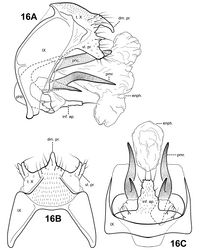Itauara lucinda
| Notice: | This page is derived from the original publication listed below, whose author(s) should always be credited. Further contributors may edit and improve the content of this page and, consequently, need to be credited as well (see page history). Any assessment of factual correctness requires a careful review of the original article as well as of subsequent contributions.
If you are uncertain whether your planned contribution is correct or not, we suggest that you use the associated discussion page instead of editing the page directly. This page should be cited as follows (rationale):
Citation formats to copy and paste
BibTeX: @article{Robertson2011ZooKeys114, RIS/ Endnote: TY - JOUR Wikipedia/ Citizendium: <ref name="Robertson2011ZooKeys114">{{Citation See also the citation download page at the journal. |
Ordo: Trichoptera
Familia: Glossosomatidae
Genus: Itauara
Name
Itauara lucinda Robertson & Holzenthal sp. n. – Wikispecies link – ZooBank link – lucinda Pensoft Profile
Description
This species is similar to Itauara alexanderi sp. n., Itaura emilia sp. n., and Itaura stella sp. n., as discussed under each of those species. Each of these species possess an inferior appendage process, a dorsomesal process on tergum X, and rather sinuous parameres. Among these species, Itaura lucinda is distinct in having forked parameres and a non-bifid inferior appendage process.
Adult. Body, wings, and appendages fuscous, intermingled with rufous or golden hairs, tibia and tarsi tawny brown. Wings with white transverse line along anastomosis. Forewing slightly broader past anastomosis, but with margins nearly parallel, apex subacute. Forewing venation incomplete, with apical forks I, II, and III present; Sc and R1 distinct along their entire lengths; fork I sessile; fork II petiolate, stem about the same length as fork; fork III petiolate, stem longer than fork; Cu1 complete, reaching wing margin; Cu1 and Cu2 intersecting near anastomosis; row of erect setae present along Cu2; A3 absent; discoidal cell longer than Rs vein. Hind wing margins nearly parallel, tapering only slightly past anastomosis; apical forks II and V present; Sc and R1 fused basally; A2 absent. Tibial spurs 1,4,4, foretibial spur extremely reduced and hairlike. Sixth sternal process thumb-like, apex attenuate and pointed, associated with oblique apodeme posteriorly.
Male genitalia. Preanal appendages absent. Segment IX dorsally narrow, broad medially and ventrally; anterior margin rounded; posterolateral margin membranous or very lightly sclerotized; sternum IX without modification. Tergum X incompletely fused to tergum IX with membrane or lightly sclerotized region ventrolaterally; dorsomesal margin with single, downturned, elongate process; dorsolateral margin without processes; ventrolateral margin with paired, broad flange-like setose process with small upper lobe and larger subquadrate lower lobe. Inferior appendages present as single, broad, subquadrate setose process, broadest basally, fused to phallobase ventrobasally, with 2 pairs of small digitate lobes ventrolaterally, each bearing a seta. Parameres present, paired, inserted in membranous lobe, arising laterally from endotheca, sclerotized and rod-like, bifid, with short lower process and longer, slightly medially bent upper process, directed posteriorly, apices pointed. Phallobase reduced, lightly sclerotized. Phallicata forming a long, straight sclerotized dorsal sheath extending from phallobase. Endophallus membranous, enlarged and convoluted when invaginated, with 1 upper and 1 lower lobe.
Material examined
Holotype male: BRAZIL: Minas Gerais: Parque Nacional do Caparaó, small trib. to Rio Caparaó, Vale Verde, 20°25'02"S, 041°50'46"W, 1350, 12–14.iii.2002 (R.W. Holzenthal) (UMSP000052593) (MZUSP).
Paratype: BRAZIL: Minas Gerais: same data as holotype — 1 female (UMSP).
Etymology
We are delighted to name this species for the senior author’s daughter, Lucinda Grace Thompson.
Original Description
- Robertson, D; Holzenthal, R; 2011: Revision of the Neotropical caddisfly genus Itauara Müller, 1888 (Trichoptera, Glossosomatidae) ZooKeys, 114: 41-100. doi
Images
|
